
table of contents
- Extremely different looks
- Types from A - F
- Species with G
- Species with H
- Types from I - R
- Types with S
- Types from T - Z
- frequently asked Questions
At the sight of a spider, opinions can differ. Some people are just disgusted, others are fascinated. There are many species of spiders. Below is a small list of local spiders.
In a nutshell
- correct name weaving spiders (Araneae)
- very different in appearance
- there are around 1,000 domestic spiders in Germany
- Big angle spider one of the largest spiders in this country
Extremely different looks
The term spiders is not entirely correct, more precisely it is web spiders (Araneae). They belong to the genus of arachnids. There are many different species of spider, some only a few millimeters in size. others a little bigger. Many monochrome, some colored or with marks on the body. Even if the appearance can be quite different, all spiders have one thing in common, their physique:
- Head and chest fused (prosoma)
- articulated, stalked, large abdomen (opisthosoma)
- strong mouthparts (chelicerae)
- eight legs
- eight point eyes
Note: Spiders have a firm exoskeleton, which limits their growth. The shell is completely thrown off by the skinning and after that the spider is a fifth larger.
Around 1,000 species of spiders are native to Germany. Below is a small list of known and less known species.
Types from A - F
Canopy spider (Linyphia triangularis)

- Body length: 6 mm
- Occurrence: August to October
- Distribution: bushes, Conifers
- Appearance: colored brown on top with light markings, underside much darker, spherical abdomen
- Nets: tightly woven, hung horizontally
Note: This species of spider hangs upside down under the web and is well camouflaged by its color. Flying insects are brought down by the threads and fall into the net.
Window spider (Amaurobius fenestralis)
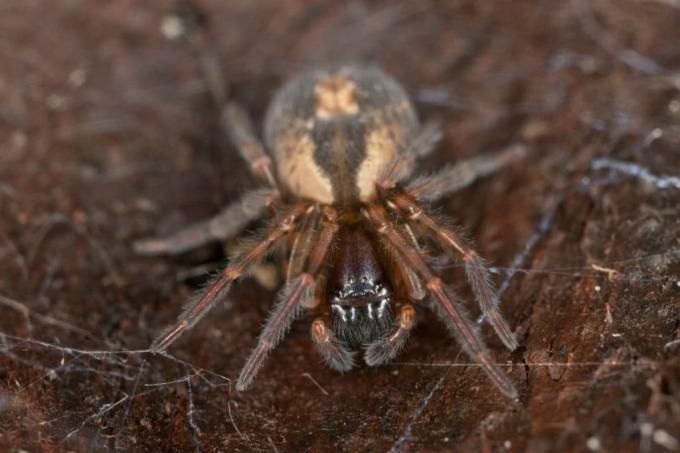
- Body length: 12 mm
- Occurrence: all year round
- Distribution: in forests, especially in low mountain ranges
- Appearance: round abdomen, greenish to brownish in color, brownish head and chest area, darkly set head, a very large pair of eyes, legs slightly hairy, brown and darkly curled
- Nets: consisting of a funnel with a dwelling cave behind it
- Special features: Spider dies after laying eggs and is eaten by young.
Species with G
Garden spider (Araneus diadematus)

- Body length: 20 mm
- Occurrence: July to October
- Distribution: in forests, bushes and hedges
- Appearance: large, spherical abdomen, pale to dark brownish color with variable markings, always cross-shaped in the upper half, White markings, edges of the abdomen white, small whitish hairy head, long strong legs, black and white ringed hairy ones Pine button
- Networks: circular, filigree, stretched on holding threads, spider sitting in the middle
Note: Prey animals caught in the net are paralyzed with a poison bite and wrapped in a cocoon. Then they are sucked out.
Large woodlouse hunter (Dysdera crocata)
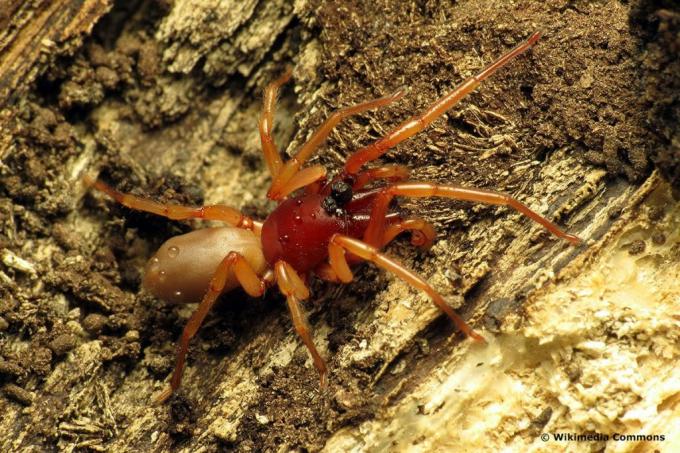
- Body length: 15 mm
- Occurrence: June to October
- Distribution: forests, parks, gardens, buildings, greenhouses
- Appearance: only three pairs of eyes, long oval, light brown abdomen, head and chest area dark to reddish brown, mouth probe like a hook or sickle, contain poisonous claws, legs reddish brown
- Special features: resting in webs of flats during the day, catching prey at night (woodlice, insects)
Big angle spider (Eratigena atrica)
House angle spider

- Body length: 20 mm
- Occurrence: all year round
- Distribution: in deciduous forests, hedges, bushes, barns, cellars, apartments, always close to the ground
- Appearance: oval, dark abdomen with brownish to gray markings, head and chest area light and dark, long, strong legs
- Nets: funnel nets in room corners
- Special features: runs very quickly, one of the largest spiders in Germany
Great trembling spider (Pholcus phalangioides)

- Body length: 9 mm
- Occurrence: all year round
- Used in: apartments, basements
- Appearance: small body, elongated oval brownish abdomen, almost circular, light head and chest area, radial legs, length is five times the length of the body
- Nets: often on room ceilings, sticky
Species with H
Harlequin Spring Spider (Salticus scenicus)
Zebra jumping spider
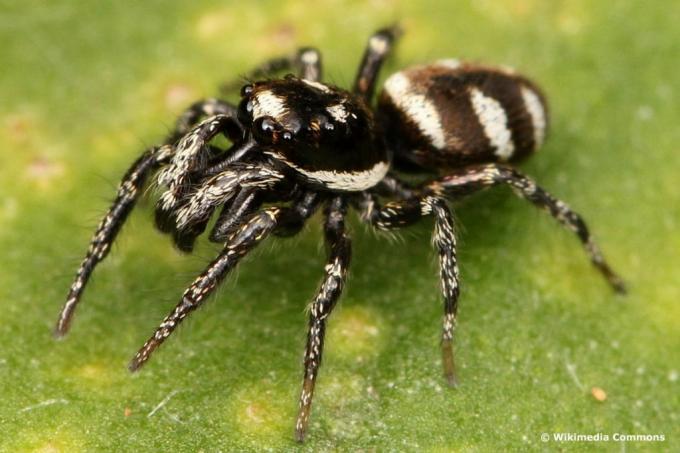
- Body length: 7 mm
- Occurrence: May to October
- Distribution: in warm places such as walls, stones, rocks and walls of buildings, all over Germany
- Appearance: densely hairy, abdomen brown with white markings, head and chest area brown or darker with white Drawing, one pair of eyes enlarged, palpable mouth palette, thickened like a club at the end, short legs, light or dark brown curls
- Special features: wanders around seeking prey, overwhelms prey with one jump
Crested web spider (Enoplognatha ovata)

- Body length: 5 mm
- Occurrence: June to July
- Distribution: in sunny places
- Appearance: spherical abdomen, yellowish, sometimes bright red markings possible, head and chest area smaller, without markings, long white legs, darkly ringed
- Special features: lurks prey for plants
Autumn spider (Metellina segmentata)

- Body length: 10 mm
- Occurrence: May to November
- Distribution: on embankments, bushes, trees
- Appearance: whitish-brownish abdomen with dark-brownish to reddish markings, large whitish head patterned with brownish elements, long whitish-brownish ringed legs
- Nets: stretched at an angle, to catch prey for smaller flying insects
- Special features: mainly active in late summer and autumn
Cave spider (Nesticus cellulanus)

- Body length: 6 mm
- Occurrence: all year round
- Distribution: damp caves, cellars, walls
- Appearance: brown to green-brown glossy, inconspicuously ringed, first pair of legs greatly elongated, back label with an indistinct pattern, abdomen with heart-shaped spot, white short hair
- Nets: wheel nets, spider upside down in them
- Special features: need darkness and moisture
Types from I - R
Crab spider (Misumena vatia)
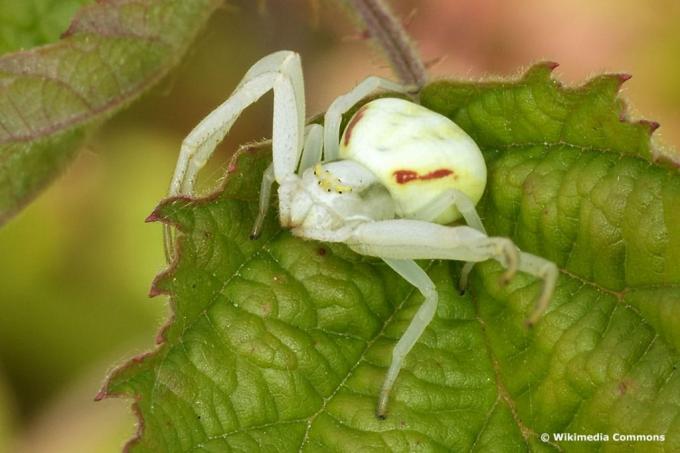
- Body length: 8 mm
- Occurrence: May to August
- Distribution: in natural landscapes with many flowers
- Appearance: oval abdomen indented to the rear, first pair of legs extended, males brown with white markings, females with variable body color
- Special features: Females lie in wait for prey and can take on the color of yellow, white or green flowers
Note: This species of spider can walk backwards and sideways.
Pumpkin Spider (Araneus cucurbitina)

- Body length: 7 mm
- Occurrence: May to July
- Distribution: in forests, gardens and parks
- Appearance: spherical abdomen with spinneret glands, marbled and dotted in shades of green and yellow, small brownish head, strong short legs, slightly hairy and shimmering greenish
- Nets: standing horizontally to diagonally on free-standing trees
List spider (Pisaura mirabilis)
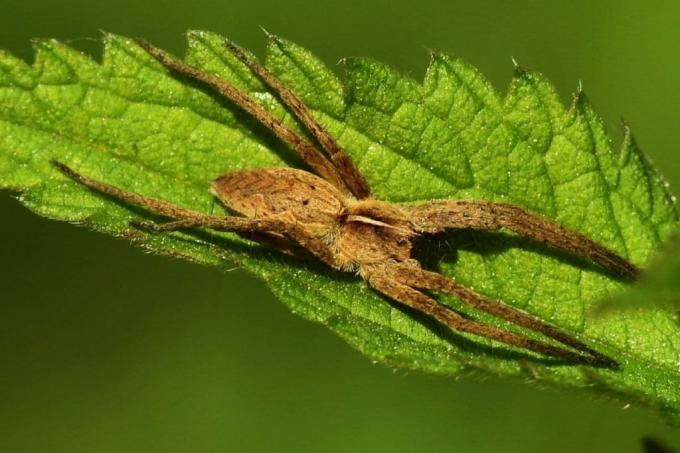
- Body length: 15 mm
- Occurrence: May to July
- Distribution: throughout Germany, on the plains, loves sunbathing on plant leaves
- Appearance: elongated, long thin brownish legs, abdomen narrow and elongated oval, light to yellowish with pronounced dark markings, head and chest area whitish to yellowish with Longitudinal drawing
- Special features: skillful, fast hunter, rushes at the prey at full speed
Note: For courtship, the female receives a prey animal woven into it from the male. It only mates if it accepts it.
Types with S
Sector spider (Zygiella x-notata)

- Body length: 7 mm
- Occurrence: July to November
- Distribution: near buildings, on window frames, under piles of wood
- Appearance: silvery colored, spherical abdomen, drawing in the form of an oak leaf in dark Shades of gray, large brownish-black head, strong, slightly hairy legs, silvery colored and dark gray curls
- Special features: Net near buildings, one sector left out, signal thread runs through it, indicates that prey has been caught
Stone slab spider (Drassodes lapidosus)

- Body length: 13 mm
- Occurrence: all year round
- Occurrence: Meadows, dry forests, sometimes also in buildings
- Appearance: slightly flattened, light brown, oval, dotted abdomen, head and chest area somewhat lighter, strongly pronounced poisonous claws, long, strong, slightly hairy legs, darkened at the end
- Special features: nocturnal, resting during the day in a dense, sack-shaped web
Silver spider (Argyroneta aquatica)

- Body length: up to 15 mm
- Occurrence: all year round under water, during the cold season in winter rigor
- Distribution: shallow waters, lakes, moors, riparian regions
- Appearance: Males colored beige-yellow, dark red legs, females brown, black long and pointed poison claws
- Networks: bell-shaped
- Special features: must be on the surface of the water to breathe, can stay under water for up to four days, air supply in a net bell
Note: The water spider is on the red list of endangered spider species and is classified as critically endangered.
Types from T - Z
Tiger spider (Argiope bruennichi)

- Body length: up to 15 mm
- Occurrence: July to October:
- Distribution: sunny terrain, dry grassland, wasteland
- Appearance: large abdomen with wasp-like markings, small front body, silvery hairy, dark brown ringed legs
- Nets: a tightly woven wheel net in the middle, vertical zigzag bands at the top and bottom
Wolf spider (Trochosa ruricola)

- Body length: 15 mm
- Occurrence: all year round
- Distribution: in forests under leaves, bushes and hedges, parks, gardens, on meadows
- Appearance: rear and front part of the same size, abdomen dark brown to gray, sometimes with light stripes and spots, strong head and chest area, brown with light stripes, one pair of eyes particularly large, brownish, slightly hairy palpebras, strong legs
- Special features: night catching of prey, rest breaks under stones, pieces of wood or leaves during the day
frequently asked Questions
Yes. In human blood, oxygen is bound to a molecule that contains iron. Hence the red color. In spiders, however, this molecule contains copper. The blood turns blue for this reason.
There are three types of poisonous spiders in this country: the garden spider, the relatively rare thorn finger and the water spider. However, the spiders don't bite by themselves, they have to be irritated or cornered to such an extent. The bites can be a little painful, but are usually not fatal. However, complications can occur in allergy sufferers.
Using a mosquito pen can be helpful. There is a metal plate at the top. This must be pressed onto the bite wound. There it heats up and destroys the poisonous protein. In any case, a doctor should be consulted after such a bite. It is also important not to scratch the bite wound. Otherwise infections can occur.

